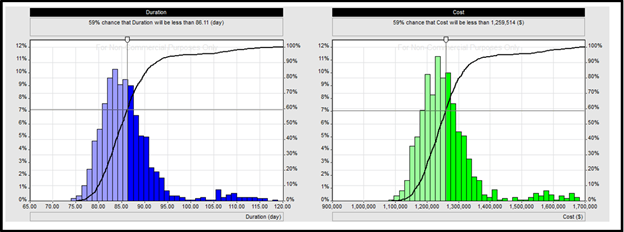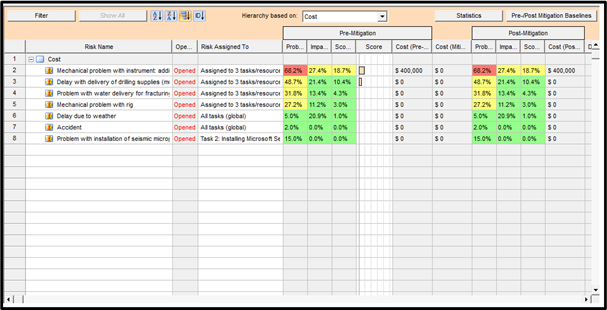A major flaw in traditional methods of cost risk analysis is that it does not adequately account for variances in time dependent costs. Time dependent costs are associated with resources with unit rates (hourly/daily) that can expand or contract if more or less time is required to complete project activities and can be a major source of cost risk in many projects. Therefore it is crucial that the assumptions underlying a project cost and schedule risk analysis coincide with each other. Through the use of resource loaded schedules along with risk events and uncertainties in a Monte Carlo risk analysis.
A resource loaded schedule includes a high quality project schedule with enough detail to model to sufficiently model activity durations and dependencies. For the purposes of this type of analysis simplified or high level models of more detailed schedules can be used as without loss of validity as long as high level activities dependencies are maintained. All time dependent costs will be modelled by assigning project resources with rates. Depending upon the nature of the project, resource groups with a group rate can be used to simplify the data. Rates can be for any appropriate unit of duration that is in scale with the scope of the projects. Fixed cost, those costs that are not time dependent, can be also be included as part of the analysis as they can constitute a significant portion of both overall project cost and cost variance.
The Monte Carlo simulation requires additional risk assessment data that can include risk events or uncertainties. Risk events are also referred to as risk drivers and are events that may occur during the course of a project that will affect project schedule and cost. Risk events have a probability or chance of occurrence and one or more impacts. Probability is entered as a percentage which is an estimate of what the chance that the risk event will occur during project execution. The probability value can be derived from examining the relative frequency in which the risk has occurred in previous analogous projects in combination with expert judgement. Impacts are entered in as both type – the project parameter affected by the risk, and magnitude – fixed or relative. Though risks can impact other project parameters such as quality, safety, etc., you only need to add cost and schedule impacts.
Once you have assigned risk events and uncertainties to the resource loaded schedule, you can run the Monte Carlo simulations. The Monte Carlo simulations will produce frequency histograms, cumulative probability plots as well as automatically prioritize project risks in terms of impact on cost, schedule, and other parameters.
In Figure 1 we can see a typical results of an integrated cost and schedule Monte Carlo simulation. The charts are configured to show the frequency histogram and the cumulative probability for both project cost and duration. Looking at the distribution curve there are a couple of features that are worth noting. First, the distribution curves of both the duration and cost results are very similar. This shows how the assumptions that drive cost and schedule estimates and be aligned using this methodology. Second, the impact of risk events are readily visible on these charts. Unlike the more familiar smooth curved distributions that appear using traditional 3 pt estimates, the charts in Figure 1 are somewhat irregular with long bumpy tails to the right. The “bumps” show the impact of events that if they occur during project execution will increase both cost and schedule.

Figure 1. Cost and Schedule Risk Analysis
The next step then is to identify which of those risk events are the main drivers behind the cost and schedule variance as evidenced by the long bumpy tail we see in the above example. Previously without the use of risk events, this could have meant taking the results and performing a root cause analysis to reveal the underlying cause of the variance; however, in this case it is a simple process. As risk events are directly assigned with probability and impact to the resource loaded schedule, by analyzing the correlation between the impact of the risk on the overall project results during the simulation, the risk register can automatically rank risks in terms of impact on cost and schedule. Further, it is possible through a process of turning risks on and off and repeating the simulations to determine the expected cost impact of each risk which is very valuable during risk planning.

Figure 2: Rank risks by cost impact
In conclusion, integrated cost and schedule risk analysis is a very powerful methodology of ensuring that the underlying assumptions of cost and schedule estimates are aligned. Further, the use of risk events can provide a more realistic understanding of the potential impact risks will have on you project, but will automatically prioritize your project risks according to their impact on project parameters and improve your risk response planning.
For more information about Intaver Institute’s risk analysis and risk management methodology please read our Schedule Risk Analysis article.




